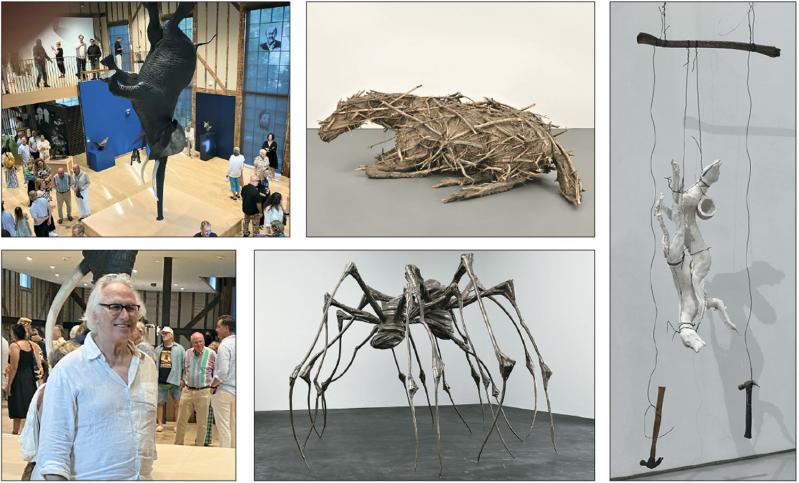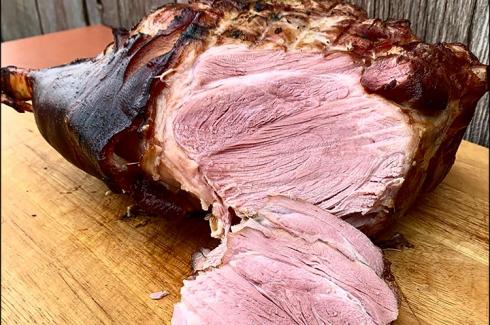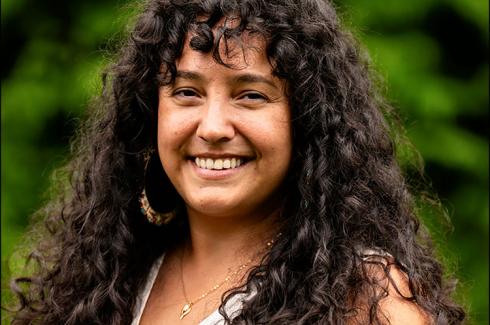The idea began to germinate a couple of years ago. Eric Fischl, the artist and co-founder of The Church in Sag Harbor, clicked on a Pinterest feed in his email and came upon a photograph of a cat. More specifically, a sculpture of a cat by the British artist Nichola Theakston.
“I was attracted to the animal and to the way the hands made this piece,” Mr. Fischl told a visitor to the exhibition. “It was beautifully controlled, and the animal had such sentient qualities to it. I clicked on it and went down a rabbit hole, pun intended, to a world I didn’t know anything about, which was the world of animal sculptors.”
The result of that excursion was “The Ark,” an exhibition consisting entirely of animal sculptures by over 40 international artists that opened at The Church two weeks ago.
“One of the principal ideas that we’ve had is looking for ways of empowering an audience before they walk in the door. You break down some of the intimidation so that people who don’t have art in their lives, don’t know how to use art in their lives, aren’t intimidated. We do theme shows with that in mind.”
Previous exhibitions have focused on typewriters, bicycles, guitars, boxing, and cars. “Who doesn’t know something, feel something, love something related to animals?” said Mr. Fischl. As the idea for the show evolved, he knew he didn’t want to involve painting, photographs, any flat work, because the show would be so big that it would be a challenge to organize it with any clarity.
“Plus, there’s something about sculpture that gives you an immediate body connection to the other, and your hands often just reach out without even thinking about it. Sculpture seemed like a very clear way of getting people to connect with the thing they’re looking at. That’s where the creativity shows up, that’s where people begin to understand the life of the creative mind, where you take the familiar and explode it into wonder, explode it into power, into mysticism, into humor, into pleasure, into pain.”
That connection happens as soon as one climbs the stairs leading to the main floor, where in the center of the vast space is Daniel Firman’s “Le Sommeil en Forêt (The Sleep in the Forest),” an 18-foot-tall freestanding elephant balancing on the tip of its trunk. If ever there was a “wow” moment!
What is even more extraordinary is that the piece was made using 3-D printing, PETG (a type of polyester), metal, and paint. “Daniel said he had 10 printers going for 8,000 hours, that it was just nonstop,” Mr. Fischl said. They were printing 11-by-11-inch pieces that had to be assembled, and all the seams had to be cleaned.
While it’s the largest and probably most dramatic piece in the show — though it has a lot of competition — it isn’t the heaviest. That honor belongs to Deborah Butterfield’s “Resting Horse” (1977), which is on loan from the Whitney Museum of American Art, where it has remained in storage since it was shown in that museum’s 1978 Biennial. Because the piece must remain horizontal, getting it into the building and up the stairs was a challenge.
“The way she is sculpting this thing it shouldn’t amount to a horse. It’s mud and sticks and formed in a way that you think is not exactly following the anatomy of a horse, but you look at it and it’s a living, breathing horse, maybe foundering, maybe getting ready to just stand up again, but it’s so much a horse. I think this piece particularly is a masterpiece.”
As connected as Ms. Butterfield is with horses, Louise Bourgeois is often associated with spiders, which she began creating in 1999 with “Maman,” a sculpture more than 30 feet tall. While it might seem a daunting subject, Bourgeois has said they are portraits of her mother. “They are large because she was a monument to me. I want to walk around and be underneath her and feel her protection.”
Her “Spider Couple,” which is 12 feet in diameter, is situated on the deck located off the venue’s mezzanine. While it is the first time the deck has been used for that purpose, “the space is perfect for sculpture and for this particular sculpture,” Mr. Fischl said. “We’re very fortunate to be able to show this piece.”
On the mezzanine itself is sculpture by Bruce Nauman, an artist who has been highly influential since bursting into the art world in the late 1960s. His “2 plaster foxes head to foot with plaster can and hammer,” from 2024, is mysterious, Mr. Fischl said. Joined together, the foxes hang by wire from a wooden rod. Two hammers dangle beneath the foxes. “The hammers just sit there. What’s holding the piece in balance are two things that can destroy it.”
While much of the work is from the current century, there are pieces from the 19th century as well. William Edmondson, for example, a son of enslaved people, is represented by a carved stone bird from about 1930. Self-taught, after retiring from his job as laborer, he carved gravestones, sculpting on the side. Mr. Fischl noted “the simplicity of form, beauty, balance, all those things.”
Two carved wooden relief sculptures that depict monkeys, one from circa 1900, the other from 1930-39, were created by artisans from the Mentawai Islands, off the western coast of Sumatra in Indonesia. They are on loan from the Watermill Center Collection and the Robert Wilson Arts Collection.
Rembrandt Bugatti (1884-1916) was an Italian sculptor known for his bronze sculptures of wildlife. Of his “Girafe en Train de Boire (Giraffe About to Drink),” from 1907, Mr. Fischl noted “the quality of observation that captures the way this young giraffe has to spread its front legs to bend down to the water.”
One apparent outlier is Thomas Deininger’s 2024 “Pigeon on the Giacometti.” Approached from either side it appears to be a vertical concatenation of junk — discarded plastics, toys, a keyboard, a duck, a bicycle chainring. “What we create, celebrate, and/or disregard intrigues me,” the artist says in a catalog statement. “Working with ‘junk’ inspires me to look for the potential in what otherwise would be considered mundane.”
But the piece is not merely a comment on consumer waste. If one stands in a very specific spot, looking at the piece head-on, it becomes a Giacometti “Walking Man” with a pigeon on its head. “It’s just stuff and then you get back there and it coalesces into an incredibly exact image of a Giacometti,” said Mr. Fischl.
One of many works that drew close inspection at the opening was Kate MccGwire’s “Ravish,” a densely coiled serpentine form enclosed in a vitrine. While at first glance its abstraction seems to bear no connection to an animal, except perhaps a snake, in fact it is made from rooster feathers.
“Feathers, symbols of flight and freedom, are reconfigured into something weighty, something constrained,” the artist says in a catalog statement. “The muscular twists and knots evoke intestines, sinew, or creatures locked in an embrace both intimate and confrontational.”
The show extends outdoors, with five works on the grounds, including an eight-foot-tall bronze parrot by Jim Dine and “I’m sorry, and I won’t do it again” (2024), Angus Fairhurst’s seven-foot-tall gorilla holding its severed head in its hands.
In addition to the artists already named, the exhibition includes work by Monica Banks, Joan Brown, Maurizio Cattelan, Elisabeth Frink, Jean-François Gambino, Brendan Hesmondhalgh, Bryan Hunt, Jörg Immendorff, Ryan Johnson, and William Kent.
Other contributing artists are William Kentridge, Sherrie Levine, Sarah Lucas, Allan McCollum, John O’Reilly, Charles Ray, Germaine Richier, Jane Rosen, Susan Rothenberg, Claudette Schreuders, Jaune Quick-to-See Smith, Kiki Smith, Anthony Theakston, Nichola Theakston, Catherine Thiry, Rosemarie Trockel, William Tucker, Patrick Villas, and Daisy Youngblood.
There are too many remarkable pieces in the show to do them justice in this space. There is no substitute for seeing the exhibition, and a fully illustrated catalog that includes text contributions by many of the artists allows an even deeper dive.
“I am very excited about this show,” Mr. Fischl said. “Everybody has a connection to these animals in some way. The vibe at the opening was amazing, it was the most incredible sense of community enjoying and sharing with ease and enthusiasm and wonder. This is what art’s for.”
—
This article has been changed from its original and print version. The artist whose work is mentioned in the first paragraph is Nichola Theakston, not Nicola Hicks, as originally stated.




